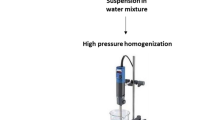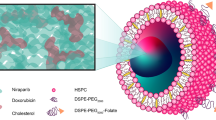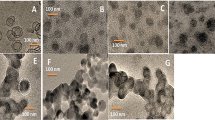Abstract
FOLFOX is a combination of folinic acid (FnA), 5-fluorouracil (5-Fu) and oxaliplatin (OxP). It has been used as the standard treatment for colorectal cancer (CRC) and hepatocellular carcinoma (HCC). This treatment is effective, but its high toxicity is dose limiting, and the drugs need to be taken for a long time. To lower the toxicity so that higher doses can be administered with minimal side effects, two lipid-based membrane–core (MC) nanoformulations, Nano-Folox and Nano-FdUMP, have recently been developed by using the nanoprecipitation technique. The combination of Nano-Folox (containing platinum drug and FnA) and Nano-FdUMP (containing fluorine drug) significantly improves the antitumor effect against CRC and HCC relative to FOLFOX (the combination of free drugs), resulting in long-term survival of animals without significant toxic signs. Here, we describe two formulation protocols. First, for Nano-Folox, a Pt(DACH)•FnA nanoprecipitate is formed by [Pt(DACH)(H2O)2]2+ (the active form of OxP) and FnA2−, and the resultant nanoprecipitate is encapsulated inside the lipid nanoparticles (NPs) modified with the PEGylated aminoethyl anisamide (AEAA, a targeting ligand for sigma-1 receptor overexpressing on CRC and HCC). Second, for Nano-FdUMP, FdUMP (the active metabolite of 5-Fu) is entrapped inside the amorphous Ca3(PO4)2 nanoprecipitate, and the resultant Ca3(PO4)2•FdUMP nanoprecipitate is encapsulated into the AEAA-targeted PEGylated lipid NPs. The procedures for Nano-Folox and Nano-FdUMP take ~17 h and ~4 h, respectively (~17 h if they are prepared simultaneously). Procedures for the physicochemical (~30 h) and cytotoxic (~54 h) characterization are also described.
This is a preview of subscription content, access via your institution
Access options
Access Nature and 54 other Nature Portfolio journals
Get Nature+, our best-value online-access subscription
$29.99 / 30 days
cancel any time
Subscribe to this journal
Receive 12 print issues and online access
$259.00 per year
only $21.58 per issue
Buy this article
- Purchase on Springer Link
- Instant access to full article PDF
Prices may be subject to local taxes which are calculated during checkout







Similar content being viewed by others
Data availability
The data that support the findings of this study are available from the references listed in Related links. Further information is available from the corresponding author upon request.
References
Ghosh Chaudhuri, R. & Paria, S. Core/shell nanoparticles: classes, properties, synthesis mechanisms, characterization, and applications. Chem. Rev. 112, 2373–2433 (2012).
Guo, J. & Huang, L. Membrane-core nanoparticles for cancer nanomedicine. Adv. Drug Deliv. Rev. 156, 23–39 (2020).
Li, J., Chen, Y. C., Tseng, Y. C., Mozumdar, S. & Huang, L. Biodegradable calcium phosphate nanoparticle with lipid coating for systemic siRNA delivery. J. Control. Release 142, 416–421 (2010).
Li, J., Yang, Y. & Huang, L. Calcium phosphate nanoparticles with an asymmetric lipid bilayer coating for siRNA delivery to the tumor. J. Control. Release 158, 108–114 (2012).
Goodwin, T. J. et al. Liver specific gene immunotherapies resolve immune suppressive ectopic lymphoid structures of liver metastases and prolong survival. Biomaterials 141, 260–271 (2017).
Hu, K. et al. Quercetin remodels the tumor microenvironment to improve the permeation, retention, and antitumor effects of nanoparticles. ACS Nano 11, 4916–4925 (2017).
Hu, M. et al. Relaxin gene delivery mitigates liver metastasis and synergizes with check point therapy. Nat. Commun. 10, 2993 (2019).
Allegra, C. J. et al. Bevacizumab in stage II-III colon cancer: 5-year update of the National Surgical Adjuvant Breast and Bowel Project C-08 trial. J. Clin. Oncol. 31, 359–364 (2013).
Qin, S. et al. Randomized, multicenter, open-label study of oxaliplatin plus fluorouracil/leucovorin versus doxorubicin as palliative chemotherapy in patients with advanced hepatocellular carcinoma from Asia. J. Clin. Oncol. 31, 3501–3508 (2013).
Kuebler, J. P. et al. Oxaliplatin combined with weekly bolus fluorouracil and leucovorin as surgical adjuvant chemotherapy for stage II and III colon cancer: results from NSABP C-07. J. Clin. Oncol. 25, 2198–2204 (2007).
Tournigand, C. et al. OPTIMOX1: a randomized study of FOLFOX4 or FOLFOX7 with oxaliplatin in a stop-and-Go fashion in advanced colorectal cancer—a GERCOR study. J. Clin. Oncol. 24, 394–400 (2006).
Guo, J., Yu, Z., Das, M. & Huang, L. Nano codelivery of oxaliplatin and folinic acid achieves synergistic chemo-immunotherapy with 5-fluorouracil for colorectal cancer and liver metastasis. ACS Nano 14, 5075–5089 (2020).
Guo, J. et al. Two nanoformulations induce reactive oxygen species and immunogenetic cell death for synergistic chemo-immunotherapy eradicating colorectal cancer and hepatocellular carcinoma. Mol. Cancer 20, 10 (2021).
Gustavsson, B. et al. A review of the evolution of systemic chemotherapy in the management of colorectal cancer. Clin. Colorectal Cancer 14, 1–10 (2015).
Banerjee, R., Tyagi, P., Li, S. & Huang, L. Anisamide-targeted stealth liposomes: a potent carrier for targeting doxorubicin to human prostate cancer cells. Int. J. Cancer 112, 693–700 (2004).
Liu, Y. et al. Nanocarrier-mediated immunogenic chemotherapy for triple negative breast cancer. J. Control. Release 323, 431–441 (2020).
Chen, Y. et al. Vasodilator hydralazine promotes nanoparticle penetration in advanced desmoplastic tumors. ACS Nano 13, 1751–1763 (2019).
Das, M., Shen, L., Liu, Q., Goodwin, T. J. & Huang, L. Nanoparticle delivery of RIG-I agonist enables effective and safe adjuvant therapy in pancreatic cancer. Mol. Ther. 27, 507–517 (2019).
Johnstone, T. C., Suntharalingam, K. & Lippard, S. J. The next generation of platinum drugs: targeted Pt(II) agents, nanoparticle delivery, and Pt(IV) prodrugs. Chem. Rev. 116, 3436–3486 (2016).
Guo, S. et al. Lipid-coated cisplatin nanoparticles induce neighboring effect and exhibit enhanced anticancer efficacy. ACS Nano 7, 9896–9904 (2013).
Guo, S. et al. Turning a water and oil insoluble cisplatin derivative into a nanoparticle formulation for cancer therapy. Biomaterials 35, 7647–7653 (2014).
Guo, S. et al. Co-delivery of cisplatin and rapamycin for enhanced anticancer therapy through synergistic effects and microenvironment modulation. ACS Nano 8, 4996–5009 (2014).
Miao, L., Guo, S., Zhang, J., Kim, W. Y. & Huang, L. Nanoparticles with precise ratiometric co-loading and co-delivery of gemcitabine monophosphate and cisplatin for treatment of bladder cancer. Adv. Funct. Mater. 24, 6601–6611 (2014).
Acknowledgements
This study was supported by an NIH grant (CA198999, to L.H.). We thank O. Gololobova at the University of North Carolina at Chapel Hill for assistance with ICP-MS and thank Z. Cong at Jilin University for assistance with HPLC.
Author information
Authors and Affiliations
Contributions
Conceptualization and writing and editing, L.H. and J.G.; funding acquisition, L.H. Both authors read and approved the final manuscript.
Corresponding author
Ethics declarations
Competing interests
L.H. is a consultant for PDS Biotechnology, Samyang Biopharmaceutical Co. and Stemirna. J.G. declares no competing interests.
Peer review
Peer review information
Nature Protocols thanks James Moon, Guangyu Zhu and the other, anonymous, reviewer(s) for their contribution to the peer review of this work.
Additional information
Publisher’s note Springer Nature remains neutral with regard to jurisdictional claims in published maps and institutional affiliations.
Related links
Key references using this protocol
Guo, J. et al. ACS Nano 14, 5075–5089 (2020): https://doi.org/10.1021/acsnano.0c01676
Guo, J. et al. Mol. Cancer 20, 10 (2021): https://doi.org/10.1186/s12943-020-01297-0
Rights and permissions
About this article
Cite this article
Guo, J., Huang, L. Formulation of two lipid-based membrane–core nanoparticles for FOLFOX combination therapy. Nat Protoc 17, 1818–1831 (2022). https://doi.org/10.1038/s41596-022-00698-3
Received:
Accepted:
Published:
Issue Date:
DOI: https://doi.org/10.1038/s41596-022-00698-3
Comments
By submitting a comment you agree to abide by our Terms and Community Guidelines. If you find something abusive or that does not comply with our terms or guidelines please flag it as inappropriate.



